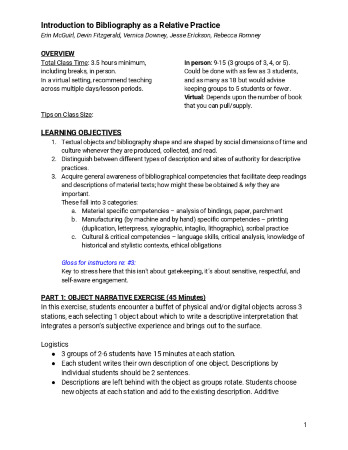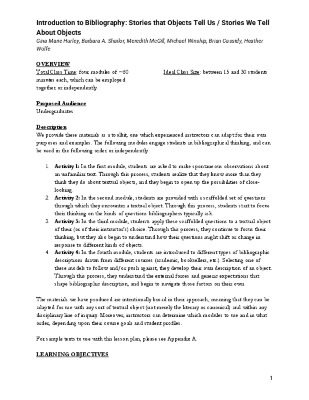Lesson Plan: Introduction to Bibliography as a Relative Practice
LEARNING OBJECTIVES
1. Textual objects and bibliography shape and are shaped by social dimensions of time and culture whenever they are produced, collected, and read.
2. Distinguish between different types of description and sites of authority for descriptive practices.
3. Acquire general awareness of bibliographical competencies that facilitate deep readings and descriptions of material texts; how might these be obtained & why they are important. These fall into 3 categories:
a. Material specific competencies – analysis of bindings, paper, parchment
b. Manufacturing (by machine and by hand) specific competencies – printing (duplication, letterpress, xylographic, intaglio, lithographic), scribal practice
c. Cultural & critical competencies – language skills, critical analysis, knowledge of historical and stylistic contexts, ethical obligations
1. Textual objects and bibliography shape and are shaped by social dimensions of time and culture whenever they are produced, collected, and read.
2. Distinguish between different types of description and sites of authority for descriptive practices.
3. Acquire general awareness of bibliographical competencies that facilitate deep readings and descriptions of material texts; how might these be obtained & why they are important. These fall into 3 categories:
a. Material specific competencies – analysis of bindings, paper, parchment
b. Manufacturing (by machine and by hand) specific competencies – printing (duplication, letterpress, xylographic, intaglio, lithographic), scribal practice
c. Cultural & critical competencies – language skills, critical analysis, knowledge of historical and stylistic contexts, ethical obligations
Erin McGuirl (created by)
Devin Fitzgerald (created by)
Vernica Downey (created by)
Jesse Erickson (created by)
Rebecca Romney (created by)
Devin Fitzgerald (created by)
Vernica Downey (created by)
Jesse Erickson (created by)
Rebecca Romney (created by)
McGuirl, Erin, Devin Fitzgerald, Vernica Downey, Jesse Erickson, and Rebecca Romney. "Introduction to Bibliography as a Relative Practice." Lesson Plan. n.d.
<https://bibsite.org/Detail/objects/20>.
<https://bibsite.org/Detail/objects/20>.
text/pdf
Introduction to Bibliography: Stories that Objects Tell Us/Stories We Tell About Objects
Gina Marie Hurley, Barbara Shailor, Meredith McGill, Michael Winship, Brian Cassidy, Heather Wolfe, Bibliographical Society of America

